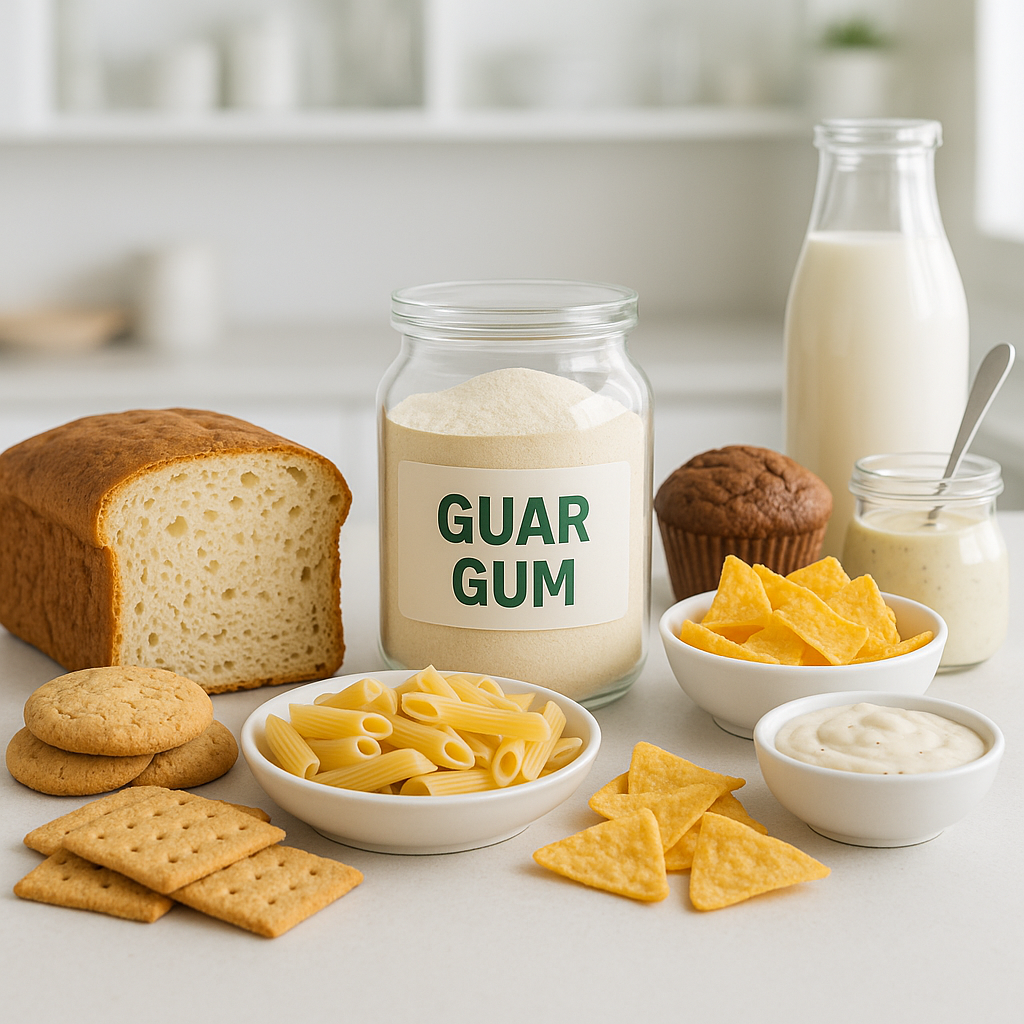
Guar gum, a natural and versatile polysaccharide derived from the seeds of the guar plant (Cyamopsis tetragonoloba), has gained significant attention in the food, pharmaceutical, and industrial sectors. One of the most compelling attributes of guar gum is its gluten-free nature, making it an ideal binder for those who suffer from gluten intolerance or celiac disease. As gluten-free diets continue to grow in popularity, especially in response to rising awareness of gluten sensitivity, guar gum offers a promising alternative for various applications, particularly in the food and beverage industries.
In this article, we will explore the unique properties of guar gum as a gluten-free binder, its applications in different sectors, and the benefits it offers in gluten-free formulations.
What is Guar Gum?
Guar gum is a water-soluble polysaccharide composed primarily of galactose and mannose units. The gum is produced by grinding the endosperm of the guar seed into a fine powder, which is then used in various applications due to its ability to form gels, thicken liquids, and bind ingredients together. Guar gum is often used as a thickening, stabilizing, and emulsifying agent in the food industry and beyond.
Unlike other gums or binders, guar gum is gluten-free, meaning it does not contain the proteins found in wheat, barley, or rye that can cause adverse reactions in individuals with gluten intolerance or celiac disease. This makes it a highly valuable ingredient for creating gluten-free products that require binding agents to hold the texture and consistency of conventional products.
Guar Gum as a Gluten-Free Binder: The Science Behind It
Guar gum’s unique molecular structure gives it a high water-binding capacity, which makes it an excellent binder and thickener. When mixed with water, guar gum forms a gel-like consistency, which allows it to bind ingredients together, thus providing structure to gluten-free products. This characteristic is especially valuable in gluten-free baking, where traditional gluten proteins are absent, and an alternative binder is needed to maintain product consistency, texture, and mouthfeel.
Guar gum acts as a substitute for gluten in gluten-free flour blends, providing the necessary binding properties to ensure the dough or batter holds together during mixing, shaping, and baking. Additionally, it helps maintain moisture in baked goods, preventing them from becoming dry and crumbly, a common issue with gluten-free products.
Applications of Guar Gum in Gluten-Free Products
- Gluten-Free Baked Goods
One of the most significant applications of guar gum is in gluten-free baking. It is commonly used in gluten-free bread, cakes, cookies, muffins, and pizza dough to mimic the properties of gluten. Guar gum improves the texture of gluten-free bread by providing elasticity, structure, and moisture retention. It also helps prevent crumbling and enhances the shelf-life of gluten-free products, which are often more prone to staleness and dryness compared to their gluten-containing counterparts. - Gluten-Free Pasta
Guar gum is also used in the production of gluten-free pasta. Without gluten, pasta made from rice or corn flour often lacks the smooth, elastic texture that traditional wheat pasta offers. Guar gum acts as a binder in gluten-free pasta dough, helping to improve texture, shape retention, and chewiness. By incorporating guar gum, manufacturers can produce pasta that is closer in quality to traditional wheat-based pasta.

- Gluten-Free Snacks
In the snack industry, guar gum serves as an effective binder for gluten-free snacks, such as crackers, chips, and granola bars. It helps hold the ingredients together, providing a satisfying texture and consistency. It also helps prevent the crumbling of gluten-free snack products, improving their overall quality and making them more appealing to consumers. - Gluten-Free Sauces and Dressings
As a natural thickener, guar gum is widely used in gluten-free sauces, dressings, and condiments. It provides the desired viscosity, enhances texture, and prevents separation, which is crucial in products like salad dressings, gravies, and sauces. Guar gum ensures these products remain smooth and uniform without the need for gluten-based thickeners. - Gluten-Free Dairy Products
Guar gum is also used in gluten-free dairy products, such as yogurt, ice cream, and milk substitutes. It helps improve the texture and mouthfeel of dairy products, preventing ice crystals in frozen desserts and ensuring smooth consistency in dairy-based beverages. Additionally, guar gum is an essential stabilizer for plant-based dairy alternatives like almond or soy milk.
Benefits of Using Guar Gum in Gluten-Free Formulations
- Improved Texture and Structure
Guar gum provides structure and texture to gluten-free products, which are typically more fragile and crumbly than their gluten-containing counterparts. In baking, guar gum mimics the effects of gluten, giving products the necessary elasticity and cohesion to hold their shape. - Enhanced Moisture Retention
Gluten-free products often suffer from dryness, especially in baked goods. Guar gum helps retain moisture, preventing the product from becoming stale quickly. This quality makes guar gum particularly beneficial in gluten-free bread and cakes, where moisture retention is key to a soft, appealing texture.
- Increased Shelf Life
Guar gum can extend the shelf life of gluten-free products by preventing moisture loss and reducing the likelihood of staleness. It helps to preserve the texture and freshness of products, making them more suitable for retail distribution. - Non-Allergenic and Natural
Guar gum is a natural, plant-derived product that is free from gluten and other common allergens such as soy, dairy, and eggs. This makes it an ideal choice for individuals with dietary restrictions, ensuring that gluten-free products are safe and accessible for a broad range of consumers. - Versatility Across Applications
Guar gum is highly versatile and can be used in a variety of food and industrial applications beyond just baking. Its ability to act as a thickener, stabilizer, and binder makes it useful in a range of products, from gluten-free pasta to sauces, soups, dairy alternatives, and more.
Guar Gum in the Pharmaceutical Industry
In addition to its uses in the food industry, guar gum also serves as a binder in the pharmaceutical industry. Guar gum is used in the formulation of tablets and capsules as a binding agent, helping to ensure uniformity and consistency in dosage. Its natural, gluten-free composition makes it an ideal choice for pharmaceutical products targeted at individuals with gluten sensitivities.
Guar gum is also used in controlled-release drug formulations. Its ability to swell in water allows it to slow the release of active ingredients, making it suitable for creating sustained-release medications. This characteristic of guar gum is particularly beneficial in the development of gluten-free pharmaceutical products.
Environmental Impact of Guar Gum
Another benefit of guar gum is its relatively low environmental impact. The guar plant is drought-resistant and grows well in arid regions, requiring minimal water for cultivation. This makes guar gum a more sustainable choice compared to other thickeners and binders, which may have higher environmental footprints. Additionally, the processing of guar gum is relatively low-energy compared to synthetic alternatives, contributing to its sustainability.
Conclusion
Guar gum is a powerful and versatile ingredient that serves as an ideal gluten-free binder in a variety of food, pharmaceutical, and industrial applications. Its natural, plant-based composition makes it a safe and effective alternative to gluten-based binders, providing improved texture, moisture retention, and shelf life in gluten-free products. From gluten-free baked goods to dairy products and pharmaceuticals, guar gum’s unique properties make it an indispensable component in the creation of gluten-free formulations.
As consumer demand for gluten-free products continues to rise, guar gum will remain a key ingredient in meeting the needs of individuals with gluten sensitivities. Its versatility, sustainability, and functional benefits ensure that guar gum will continue to play a vital role in the development of innovative gluten-free products in the years to come.



